The Bachelor Police (Spanish : Policias Bachilleres) is an auxiliary or police support organisation in the Colombian National Police, consisting of adolescents and young adults over 18 years old and/or those who have completed their high school leaving certificate and need to complete their obligatory military service. [1]
According to the Constitutional Law 48 of March 3, 1993, which controls recruitment and mobilisation in the military forces of Colombia, potential recruits have the option of completing their obligatory military service after graduating from high school and/or achieving legal age. This may be in the Colombian National Police for 12 months instead of the serving in the Colombian Armed Forces. "Bachelor Policemen" do not carry firearms but wear basic National Police uniform without insignias, usually supporting the regular police in surveillance and traffic duties with whistles, two-way radios, bicycles and batons. [2]
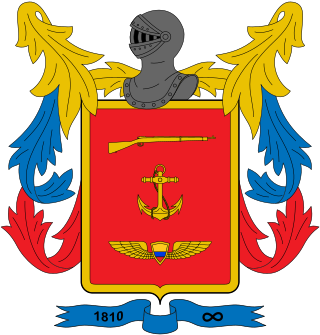
The Military Forces of Colombia are the unified armed forces of the Republic of Colombia. They consist of the Colombian Army, the Colombian Navy and the Colombian Aerospace Force. The National Police of Colombia, although technically not part of the military, is controlled and administered by the Ministry of National Defence, and national conscription also includes service in the National Police, thus making it a de facto gendarmerie and a branch of the military. The President of Colombia is the military's commander in chief, and helps formulate defense policy through the Ministry of National Defence, which is in charge of day-to-day operations.
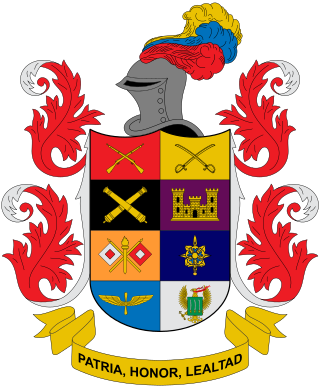
The National Army of Colombia is the land warfare service branch of the Military Forces of Colombia. With over 361,420 active personnel as of 2020, it is the largest and oldest service branch in Colombia, and is the second largest army in the Americas after the United States and before Brazil.

The Mexican Army is the combined land and air branch and is the largest part of the Mexican Armed Forces; it is also known as the National Defense Army.
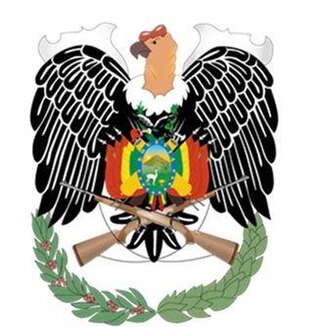
Law enforcement in Bolivia is reliant on the 40,000-member Cuerpo de Policía Nacional responsible for internal security and maintaining law and order. Unlike many South American countries, the Bolivian police force always has been accountable to the national government rather than to state or local officials. The 1950 Organic Law of Police and Carabiniers officially separated the police from the military. Frequently, however, the national police call upon the military for assistance in quelling riots and civil protests.
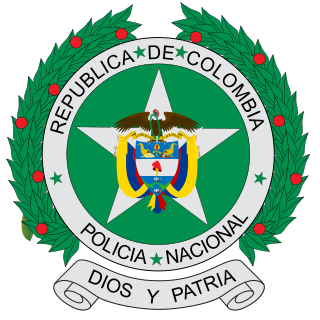
The National Police of Colombia is the national police force of the Republic of Colombia. Although the National Police is not part of the Military Forces of Colombia, it constitutes along with them the "Public Force" and is also controlled by the Ministry of Defense. The National Police is the only civilian police force in Colombia. The force's official functions are to protect the Colombian nation, enforce the law by constitutional mandate, maintain and guarantee the necessary conditions for public freedoms and rights and to ensure peaceful cohabitation among the population.
The Middle Magdalena Bloc of the FARC-EP was a FARC-EP bloc, notable for its involvement in the conflict with the AUC until the latter's demobilization in 2004. After that, it became one of the Colombian army's biggest worries as FARC started once again to gain control over the territory.
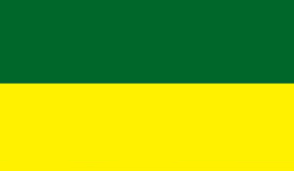
General Santander National Police Academy is the main educational center for the Colombian National Police. The academy functions as a university for the formation of its force.
The Directorate for Citizens Security or Dirección de Seguridad Ciudadana is a branch of the Colombian National Police, currently led by Operative Director Brigadier General Luis Alberto Gómez, controls strategic police services in cities, metropolitan areas, police departments and decentralized units.. It was formerly known as the Direccion Operativa or Operations Directorate. The Directorate for Citizens Security is responsible for the general supervision of the 8 National Police regions
The Directorate of Criminal Investigation and Interpol Spanish: Dirección de Investigación Criminal e Interpol (DICI), formerly the Central Directorate of the Judicial Police and Intelligence is a Directorate of the Colombian National Police in charge of judicial and certain intelligence tasks.

The Federal Police, formerly known as the Policía Federal Preventiva and sometimes referred to in the U.S. as "Federales", was a Mexican national police force formed in 1999. In 2019 it was incorporated into the National Guard and operated under the authority of the Department of Security and Civil Protection.

The Carabineros de Chile are the Chilean national law enforcement gendarmerie, who have jurisdiction over the entire national territory of the Republic of Chile. Created in 1927, their mission is to maintain order and enforce the laws of Chile. They reported to the Ministry of National Defense through the Undersecretary of Carabineros until 2011 when the Ministry of the Interior and Public Security gained full control over them. They are in practice separated fully from the three other military branches by department but still are considered part of the armed forces. Chile also has an investigative police force, the Investigations Police of Chile, also under the Interior and Public Security Ministry; a Maritime Police also exists for patrol of Chile's coastline.
Law enforcement in Nicaragua falls under the jurisdiction of La Policia Nacional of Nicaragua. They are in charge of regular police functions and sometimes work in conjunction with the Nicaraguan military, making it an indirect and rather subtle version of a gendarmerie.

The Police Community of the Americas or Ameripol is a hemispheric mechanism of cooperation police organization created in 2007.
Colombian military decorations date back as far as the founding of the country. An early decoration was the Cruz de Boyacá that was awarded to the generals who led their forces to victory in the Battle of Boyacá in 1819. This early decoration lives on today as an incarnation of the highest order presented by the Colombian state. There is one decoration higher, but it is only awarded for military conflicts in defence of Colombia. Other than military decorations, Colombia presents decorations on behalf of the National Government, decorations for the National Police, and decorations from the Congress of Colombia.

The National Police of Panama is the national police of Panama, under the Panamanian Public Forces. Established by the National Police Act No. 18 of June 3, 1997, it is responsible for maintaining public order nationwide. The National Police, together with the National Aeronaval Service, National Border Service, Institutional Protection Service, and National Migration Service, make up the Public Forces. Since 2010, the National Police has reported to the President through the Minister of Public Security.
The National Police of Honduras is the uniformed police force of the Republic of Honduras. The force is organised into regional headquarters, municipal headquarters, headquarters of fixed or mobile stations, and police posts. There are at least 360 police centres throughout Honduras. The National Police of Honduras has its headquarters in Tegucigalpa, the capital city of Honduras. The National Police of Honduras is the fourth largest police body in Central America by number of employees. It is the sixth largest force in Central America by police officers per capita. The force's patroness is the Virgin of Carmen. On 16 July of each year the "National Police Patroness Day" is celebrated.

The National Police of Uruguay is a national and institutional police force of the Republic of Uruguay, founded on December 18, 1829. It depends on the Executive Power through the Ministry of the Interior. Its assigned responsibility is to ensure compliance of laws in its population and to prevent crimes.